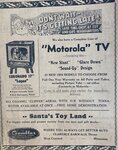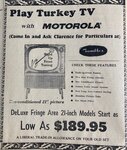




Recently I stepped into the 50’s/60’s room at the Museum and found myself lost in time remembering the era when television first came to West Concord. What sparked my memories was a black panther TV lamp sitting on a 1949 RCA Victor television with a mighty small screen. TV lamps were a part of the television culture back then. Families watched TV in a dark room because the screens of the first sets were often small and had very low luminosity. People feared that sitting close and watching TV in darkness would cause eyestrain. This was the motivation for a 10 year heyday of the TV lamp industry. If you’re as old as I am, or almost, do you remember a lamp sitting on top of your family’s TV? They were often glazed ceramic lamps, both decorative and functional. They were backlit by one bulb that emitted a soft glow. Television lamps were often given as a free incentive to purchase a TV. Animals, birds, sea creatures, and transportation modes were featured in the lamps and they became almost a kind of “hood ornament” for televisions.
Experimental TV broadcasting actually began back in 1929, but it wasn’t until 1939 that NBC was the first company to have regular broadcasts to just 400 TV sets in New York. In the 30’s only the wealthy could afford televisions. They ranged in price from $200 to $600 at a time when the average yearly income was $1368. That would be a whopping 15 to 44% of an average family’s entire annual income.
During World War II television production was placed on hold to put all efforts and materials into what was needed for the war, but the growth of the television industry after the war was rapid. There were 6000 TV sets in American homes in 1946. By 1951, in prosperous times, 12 million sets lived in U.S. living rooms—and just 4 years later in 1955, half of all American homes had televisions. Those statistics made me wonder what was happening in TV sales in West Concord. It was back to the newspapers of the 40’s and 50’s for me to check it all out.
Not one television was advertised in the West Concord Enterprise until May of 1952. I saw many ads for chest freezers, refrigerators, corn pickers, and Chevy, Ford, and Chrysler trucks and cars—but not TVs until the spring of ’52 when Pirkl and Hall offered a 20 inch Admiral TV, with the “clearest picture” available. In July Pirkl and Hall
once more advertised the Admiral TV but this time with a special motivation: to be able to watch the Democratic and Republican Conventions in Chicago. As the ad said, “The largest audience in history will see the action and hear the speeches . . . You can bring
history-making events into your own home with an Admiral Television.” As we know, the nominated candidates from those very conventions, Adlai Stevenson and Dwight Eisenhower, visited Dodge County that fall for Plowville USA.
In 1953 Clarence Barwald advertised a 21 inch Motorola at his Gambles store. It featured an “eye shade filter (not sure what that meant), an eye conditioned picture,
right up front tuning, and new, long, low cabinet styling.” During the Christmas season of 1954 Gambles and Pirkl and Hall were widely advertising Coronados, Motorolas and
Admirals and promoting the idea of upgrading from 17 inch to 21 inch TVs, welcoming trade-ins.
So what were the most popular early TV shows? You remember your favorites. The early 50’s featured programs like “The Jack Benny Show”, “I Love Lucy”, “The Milton Berle Show”, “Gunsmoke”,”Red Skelton”,“What’s My Line”, and my favorite as a young child when we first got our TV, “The Howdy Doody Show”. I even sent my second grade school picture to Howdy Doody for his Smile Contest. I waited and waited to be the winner, only as a child would do— and then one day, the real winner was announced on the show and it wasn’t me. What a disappointment! In the late 50’s shows like “Leave it to Beaver”, “Father Knows Best”, and “The Honeymooners” captured America’s attention.
One of the banes of early TV was the repairs televisions often needed. There could be tubes that required replacement or rabbit ears or outdoor antennas that needed
fixing. My mother used to be so pleased when the TV went on the “blink” that she would delay repairing it for as long as Dad could tolerate it. She hated seeing our family
be “couch potatoes” when we could be outside playing or reading. Even if the TV was not broken it took some knowhow with the horizontal and vertical knobs to keep the picture from drifting and to finally stabilize it. Remember that?
In the 1950’s, Rutgers University and CBS jointly undertook a study to find out how
American families were feeling about television. Families reported that they felt more unified as the whole family gathered to watch television shows together. They said the TV was almost like another member of the family. But they also expressed concern, wondering if so much screen time was good. Doesn’t that sound like today with our screen dependency on phones, tablets, and yes, our televisions, too?
Television has become so pervasive in our lives that when Joey Tribbiani of the
“Friends” show of the 1990’s found out an acquaintance didn’t have a television he asked, “But what does your furniture point at?” I know the Sathrum family in the 50’s was very happy to arrange their furniture to point at the brand new television. How about yours?